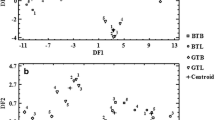Abstract
In the present paper, multi-element characterisation of 26 bagged teas was carried out using inductively-coupled plasma atomic emission spectrometry. Na, K, Ca and Mg were the metals with major contents. Among the essential elements, Fe and Zn were the most abundant, followed by Se, Cu, Mo and Cr. The tea bag samples also contained significant contents of Mn and Al. The chemometric techniques of linear correlation analysis, principal component analysis (PCA) and cluster analysis (CA) were used for differentiation of the tea bag samples according to their metal content. The samples analysed were classified into four groups by PCA and CA. The first group includes hibiscus, nettle, mint, rtanj tea, thyme, bearberry and sage. Green and black teas are in the second group. The third group contains strawberry, lime, pineapple, pomegranate, elder, blueberry, milfoil, apricot and chamomile. Exotic fruits, sweet cherry, forest fruits, apple, St John’s wort, rose hips, cherry and raspberry are in the fourth group.
Similar content being viewed by others
References
Cabrera, C., Giménez, R., & López, M. C. (2003). Determi-nation of tea components with antioxidant activity. Journal of Agricultural and Food Chemistry, 51, 4427–4435. DOI: 10.1021/jf0300801.
Cabrera, C., Artacho, R., & Giménez, R. (2006). Beneficial ef-fects of green tea — A review. Journal of American College of Nutrition, 25, 79–99. DOI: 10.1080/07315724.2006.10719 518.
Chen, Y. X., Yu, M. G., Chen, X. C., & Shi, J. A. (2009). Differentiation of eight tea (Camellia sinensis) cultivars in China by elemental fingerprint of their leaves. Journal of the Science of Food and Agriculture, 89, 2350–2355. DOI: 10.1002/jsfa.3716.
Dalluge, J. J., & Nelson, B. C. (2000). Determination of tea catechins. Journal of Chromatography A, 881, 411–424. DOI: 10.1016/s0021-9673(00)00062-5.
Hoenig, M. (2001). Preparation steps in environmental trace el-ement analysis-facts and traps. Talanta, 54, 1021–1038. DOI: 10.1016/s0039-9140(01)00329-0.
Horie, H., & Kohata, K. (2000). Analysis of tea components by high-performance liquid chromatography and high-performance capillary electrophoresis. Journal of Chromatography A, 881, 425–438. DOI: 10.1016/s0021-9673(99) 01345-x.
Institute of Medicine of the National Academies (2001). Dietary reference intakes for vitamin A, vitamin K, arsenic, boron, chromium, copper, iodine, iron, manganese, molybdenum, nickel, silicon, vanadium, and zinc. Washington, DC, USA: The National Academies Press.
Institute of Medicine of the National Academies (2004). Dietary reference intakes for water, potassium, sodium, chloride and sulfate. Washington, DC, USA: The National Academies Press.
Institute of Medicine of the National Academies (2011). Dietary reference intakes for calcium and vitamin D. Washington, DC, USA: The National Academies Press.
Kaiser, F. K. (1960). The application of electronic computer to factor analysis. Educational and Psychological Measurement, 20, 141–151.
Karak, T., & Bhagat, R. M. (2010). Trace elements in tea leaves, made tea and tea infusion: A review. Food Research Interna-tional, 43, 2234–2252. DOI: 10.1016/j.foodres.2010.08.010.
Khan, N., & Mukhtar, H. (2007). Tea polyphenols for health promotion. Life Science, 81, 519–533. DOI: 10.1016/j.lfs. 2007.06.011.
Lamble, K., & Hill, S. J. (1995). Determination of trace metals in tea using both microwave digestion at atmospheric pressure and inductively coupled plasma atomic emission spectrometry. Analyst, 120, 413–417. DOI: 10.1039/an9952000 413.
Łozak, A., Sołtyk, K., Ostapczuk, P., & Fijalek, Z. (2002). Determination of selected trace elements in herbs and their infusions. Science of the Total Environment, 289, 33–40. DOI: 10.1016/s0048-9697(01)01015-4.
Massart, D. L. (1987). Handbook of chemometrics and qualimetrics. Amsterdam, The Netherlands: Elsevier.
McKay, D. L., & Blumberg, J. B. (2002). The role of tea in human health: An update. Journal of American College of Nutrition, 21, 1–13. DOI: 10.1080/07315724.2002.10719187.
Mihaljev, Ž., Živkov-Baloš, M., Ćupic, Ž., & Jakšić, S. (2014). Levels of some microelements and essential heavy metals in herbal teas in Serbia. Acta Poloniae Pharmaceutica, 71, 385–391.
Miller, J. N., & Miller, J. C. (2005). Statistics and chemometric for analytical chemistry. New York, NY, USA: Pearson Education.
Mossion, A., Potin-Gautier, M., Delerue, S., Le Hécho, I., & Behra, P. (2008). Effect of water composition on aluminium, calcium and organic carbon extraction in tea infusions. Food Chemistry, 106, 1467–1475. DOI: 10.1016/j.foodchem.2007. 05.098.
Naczk, M., & Shahidi, F. (2004). Extraction and analysis of phenolics in food. Journal of Chromatography A, 1054, 95–111. DOI: 10.1016/j.chroma.2004.08.059.
Nishitani, E., & Sagesaka, Y. M. (2004). Simultaneous determination of catechins, caffeine and other phenolic compounds in tea using new HPLC method. Journal of Food Composition andAnalalysis, 17, 675–685. DOI: 10.1016/j.jfca.2003.09.009.
Nookabkaew, S., Rangkadilok, N., & Satayavivad, J. (2006). De-termination of trace elements in herbal tea products and their infusions consumed in Thailand. Journal of Agricultural and Food Chemistry, 54, 6939–6944. DOI: 10.1021/jf060571w.
Ražić, S., Onjia, A., & Potkonjak, B. (2003). Trace elements analysis of Echinacea purpurea-herbal medicinal. Journal of Pharmaceutical and Biomedical Analysis, 33, 845–850. DOI: 10.1016/s0731-7085(03)00338-8.
Salahinejad, M., & Aflaki, F. (2010). Toxic and essential min-eral elements content of black tea leaves and their infusions consumed in Iran. Biological and Trace Element Research, 134, 109–117. DOI: 10.1007/s12011-009-8449-z.
Szymczycha-Madeja, A., Welna, M., & Pohl, P. (2012). Elemental analysis of teas and their infusions by spectrometric methods. TrAC Trends in Analytical Chemistry, 35, 165–181. DOI: 10.1016/j.trac.2011.12.005.
Wang, H., Provan, G. J., & Helliwell, K. (2000). Tea flavonoids: their functions, utilisation and analysis. Trends in Food Science & Technology, 11, 152–160. DOI: 10.1016/s0924-2244(00)00061-3.
Wiseman, S., Waterhouse, A., & Korver, O. (2001). The health effects of tea and tea components: opportunities for standardizing research methods. Critical Reviews in Food Science and Nutrition, 41, 387–412. DOI: 10.1080/20014091091869.
World Health Organization (1996). Trace elements in human nutrition and health. Geneva, Switzerland: World Health Organization.
World Health Organization (1999). Monograph on selected medicinal plants (Vol. 1). Geneva, Switzerland: World Health Organization.
World Health Organization (2011). Lead in drinking-water. Background document for preparation of WHO Guidelines for drinking-water quality. WHO/SDE/WSH/03.04/09/Rev/1. Geneva, Switzerland: World Health Organization.
Author information
Authors and Affiliations
Corresponding author
Electronic supplementary material
Rights and permissions
About this article
Cite this article
Veljković, J.N., Pavlović, A.N., Brcanović, J.M. et al. Differentiation of black, green, herbal and fruit bagged teas based on multi-element analysis using inductively-coupled plasma atomic emission spectrometry. Chem. Pap. 70, 488–494 (2016). https://doi.org/10.1515/chempap-2015-0215
Received:
Revised:
Accepted:
Published:
Issue Date:
DOI: https://doi.org/10.1515/chempap-2015-0215




